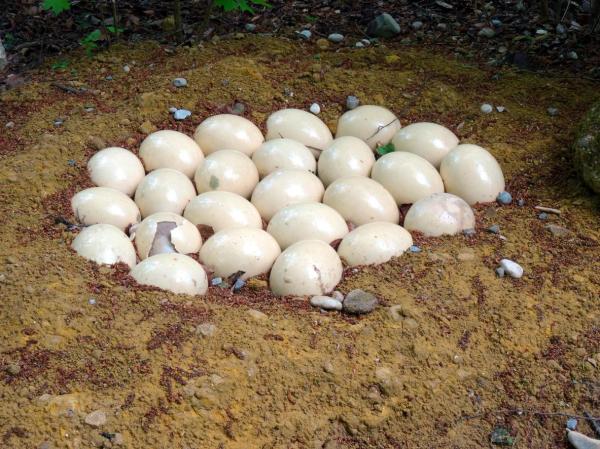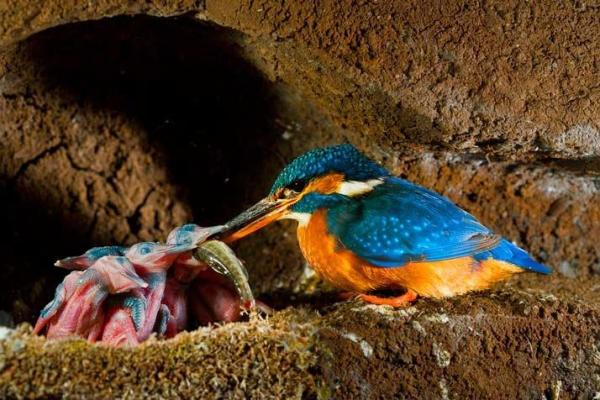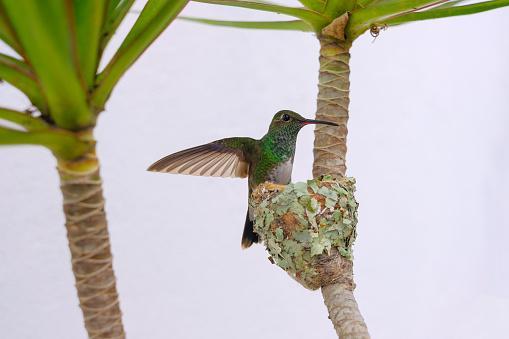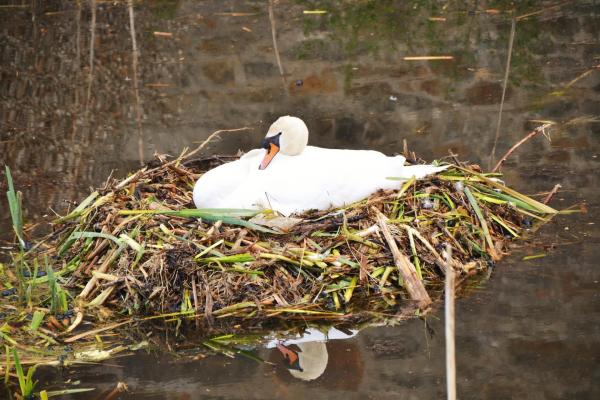
Birds are among the most fascinating creatures on our planet, and their nesting behavior is both complex and diverse. Nesting is an essential part of a bird's life cycle, providing a safe and secure place for them to lay their eggs, incubate them, and raise their young until they can fend for themselves. Different bird species have developed unique nesting strategies that suit their specific ecological needs and environmental conditions.
In this AnimalWised article, you will learn about the different types of bird nests and their key features.
Ground nest
Ground nests are a type of bird nest built directly on the ground, usually in a well-hidden location such as under a bush or in a patch of tall grass. Ground nests can vary in size and shape depending on the bird species, but often they are just a simple depression in the ground lined with materials such as grasses, leaves, or feathers.
Birds that build ground nests often have cryptic coloring that helps them blend in with their surroundings and avoid detection by predators. They may also use other strategies to protect their nests, such as building the nest in a location that is difficult for predators to access or hiding the nest in dense vegetation.
One advantage of building a ground nest is that it is well insulated and can provide a stable temperature for the eggs and young, which is especially important in colder environments. However, ground nests are also vulnerable to flooding, predation, and disturbance from human activities such as mowing or trampling.
These are some species that build these types of nests:
- Killdeer (Charadrius vociferus)
- Northern mockingbird (Mimus polyglottos)
- American woodcock (Scolopax minor)
- Ovenbird (Seiurus aurocapilla)
- Ostrich (Struthio camelus)
Below, you can see an image of an ostrich's nest. You may also be interested in this other article, where we explain the differences between a rhea vs. ostrich.

Mound nest
Some species of birds build mound nests, in which the eggs are hatched by heat generated by decomposing plant materials. This type of nest is called a "mound nest" or "incubators nest".
In mound nests, the male is responsible for maintaining the temperature in the nest by regulating the amount of plant material in the nest. As the plant material decomposes, it generates heat, and the male must remove or add material to maintain the temperature within a narrow range suitable for incubation.
Studies have shown that the temperature of the nest can have an effect on the sex of the offspring. For example, in the Australian brushturkey (Alectura lathami), higher nest temperatures tend to produce more female offspring, while lower temperatures tend to produce more male offspring.
Some birds that build mound-type nests are:
- Malleefowl (Leipoa ocellata)
- Maleus (Macrocephalon maleus)
- Red-billed turkey (Talegalla cuvieri)
It is also true that mound nests are relatively rare in birds because they require close control of temperature and oxygen levels to ensure successful incubation and hatching. Do not miss this other article where we talk about which are the best male fathers of the animal kingdom.
Below you can see the nest of a flamingo.

Burrow nest
Burrow nests are built in cavities or hollows in the ground or in other materials such as sandbars, termite mounds, or even abandoned rodent burrows. Burrow-type nests consist of tunnels that vary in depth depending on the species, and can be constructed in a variety of materials such as soil, sand, or clay. The nests can be dug into cliffs or banks, or directly into the ground with specific slopes for stability and protection from predators.
Burrow nests provide protection for eggs and chicks from predators and the elements, and help regulate temperature and humidity. Some bird species that build burrow nests line the nests with feathers, grasses, or other materials to insulate and cushion the eggs and chicks.
Building burrow nests requires specialized digging and excavation skills, and these nests are relatively uncommon in birds. However, for some bird species, they have become an effective means of protecting and providing for their offspring.
Species of birds that build this kind of nest are:
- Sand martin (Riparia riparia)
- Crab plover (Dromas ardeola)
- Barn swallow (Hirundo rustica)
- Ringed kingfisher (Megaceryle torquata)
- Burrowing owl (Athene cunicularia)
Below is an image of the burrow nest belonging to a ringed kingfisher.

Cavity nest
Another type of bird nests are those in cavities, that is, cavities in the trunks of trees or in the stems of certain large plants. Some species of birds, such as woodpeckers (Picidae), are able to create their own cavities in trees with their powerful beaks.
Other bird species, such as certain types of owls and mallards, use existing tree cavities or those created by other animals, such as squirrels or woodpeckers. These types of cavities may be called "secondary cavities" or "nest cavities". In some cases, birds also use abandoned insect nests or holes in structures such as buildings or utility poles as nesting sites.
The cavity may have a small opening and a chamber inside that may be lined with soft materials such as plant fibers, moss, or feathers to create a cozy environment for the eggs and chicks.
These are some species of birds that built or reuse cavity-type nests:
- Turquoise-fronted amazon (Amazona aestiva)
- Rufous woodpecker (Micropternus brachyurus)
- Resplendent Quetzal (Pharomachrus mocinno)
- Red-headed woodpecker (Melanerpes erythrocephalus)
- Crimson-crested woodpecker (Campephilus melanoleucos)
The following image displays the nesting site of a crimson-crested woodpecker.

Cup nest
Cup nests are a common type of bird nest. These nests are shaped like a cup and are typically made of a variety of materials such as twigs, grasses, and leaves, as well as softer materials such as moss, feathers, and animal hair. The cup shape of the nest provides a cozy, protected space for the eggs and chicks. The materials used to build it can help insulate the nest and regulate the temperature.
Shell nests can be built in a variety of places, including trees, bushes, and even on the ground. Some birds build their nests on horizontal branches, while others build them in branch forks or in tree bends. The location and materials used to build the nest can vary depending on the bird species and the availability of resources in their environment.
Cup-type nests are complex and intricate structures that can be considered works of art due to their intricate design and aesthetic appeal. These nests are renowned for their rounded shape, durability, and flexibility, which allows them to conform to the shape of the bird's body during incubation.
Among the birds that make cup-type nests, we can mention:
- Common firecrest (Regulus ignicapilla)
- Common yellowthroat (Geothlypis trichas)
- Blue-winged warbler (Vermivora cyanoptera)
- Esmeraldas woodstar (Chaetocercus berlepschi)
- House Sparrow (Passer domesticus)
The image below depicts the fascinating nest of the esmeraldas woodstar.

Platform nest
Platform nests are a type of bird nest that are flat and often wide, resembling a platform. These nests are typically constructed of twigs, grass, and other vegetation and are usually quite large compared to other types of bird nests. Platform nests are also typically larger and more substantial than cup nests.
Platform nests are typically built in trees or on rock outcrops, and may be reused by the same bird or by different bird species in subsequent breeding seasons. They provide a stable base for eggs and young birds to rest on and are often located in areas with minimal predation risk.
Examples of birds with platform-type nests include:
- Bald eagle (Haliaeetus leucocephalus)
- Osprey (Pandion haliaetus)
- Great blue heron (Ardea herodias)
- Double-crested cormorant (Phalacrocorax auritus)
- Magnificent frigatebird (Fregata magnificens)
Eagles are known to build these types of nests, and it has a lot to do with their habitat. Do not miss the following article, where we describe the different types of habitats where eagles live.
In the picture below we see an example of a platform nest built by a swan on the surface of the water.

Hanging nest
Hanging nests are a type of bird nest suspended from a branch, usually from a single attachment point. They are often woven from a variety of materials such as grass, leaves, bark, and spider webs.
These nests are usually small, lightweight, and have a pouch-like shape. They are often built by birds that live in forested areas and prefer to build their nests on the edges of tree branches, where they are hidden from predators.
Among the bird species that we can mention for this type of bird nests we have:
- Village weaver (Ploceus cucullatus)
- Baya weaver (Ploceus philippinus)
- Eurasian penduline tit (Remiz pendulinus)
- Chestnut-headed oropendola (Psarocolius wagleri)
The image below displays the hanging nest of the baya weaver bird.
Having learned about the various types of bird nests and their names, it's crucial to understand that attempting to locate these nests is not recommended. Doing so may frighten or disturb the birds, causing them to abandon their eggs or young ones. It is imperative to respect their space and allow them to nest without interference. Be sure to check out the upcoming article, where we provide instructions on what to do if you come across an injured bird.

If you want to read similar articles to Types of Bird Nests, we recommend you visit our Facts about the animal kingdom category.
- Göth, A. Incubation temperatures and sex ratios in Australian brush-turkey (Alectura lathami) mounds. Available at: https://onlinelibrary.wiley.com/doi/10.1111/j.1442-9993.2007.01709.x
- Mendoza, S. (2021). Bird nests . Avian Report. Available at: https://es.avianreport.com/nidos-de-la-aves/
- Draughn, H. (2015). Phoenicopterus roseus (online), Animal Diversity Web. Available at: https://animaldiversity.org/accounts/Phoenicopterus_roseus/
- The Cornell Lab of Ornithology. Bird nests in the Peruvian Amazon . Available at: https://celebrateurbanbirds.org/wp-content/uploads/2018/07/Nidos-flyer-180514.pdf
- SEO BIRDLIFE. Why do birds build nests? Available at: https://www.seo.org/wp-content/uploads/2019/02/intro7_ES.pdf
- Wallace, R. & Raleigh, R. (1996). Cavity-entrance orientation and nest-site use by secondary hole-nesting birds . Available at: https://sora.unm.edu/sites/default/files/journals/jfo/v065n01/p0027-p0035.pdf